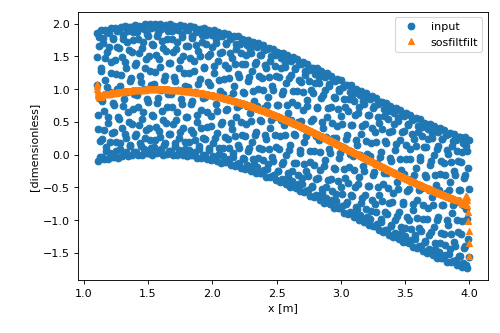scipp.signal.sosfiltfilt
scipp.signal.sosfiltfilt#
- scipp.signal.sosfiltfilt(obj, dim, *, sos, **kwargs)#
A forward-backward digital filter using cascaded second-order sections.
This is a wrapper around
scipy.signal.sosfiltfilt(). See there for a complete description of parameters. The differences are:Instead of an array
xand an optional axis, the input must be a data array (or variable) and dimension label. If it is a variable, the coord used for setting up the second-order sections is used as output coordinate.The array of second-order filter coefficients
sosincludes the coordinate used for computing the frequency used for creating the coefficients. This is compared to the corresponding coordinate of the input data array to ensure that compatible coefficients are used.
Examples:
>>> from scipp.signal import butter, sosfiltfilt >>> x = sc.linspace(dim='x', start=1.1, stop=4.0, num=1000, unit='m') >>> y = sc.sin(x * sc.scalar(1.0, unit='rad/m')) >>> y += sc.sin(x * sc.scalar(400.0, unit='rad/m')) >>> da = sc.DataArray(data=y, coords={'x': x}) >>> sos = butter(da.coords['x'], N=4, Wn=20 / x.unit) >>> out = sosfiltfilt(da, 'x', sos=sos) >>> sc.plot({'input':da, 'sosfiltfilt':out})

Instead of calling sosfiltfilt the more convenient filtfilt method of
scipp.signal.SOScan be used:>>> out = butter(da.coords['x'], N=4, Wn=20 / x.unit).filtfilt(da, 'x')
- Return type
